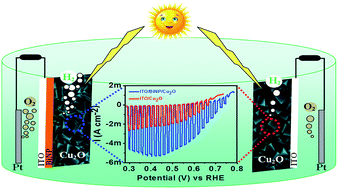Benign role of Bi on an electrodeposited Cu2O semiconductor towards photo-assisted H2 generation from water†
Abstract
In this paper we report a Bi modified Cu2O semiconductor (SC) for improved photoelectrochemical (PEC) hydrogen (H2) production from aqueous solution. For the first time, we found out that the PEC performance of SC thin films improve dramatically by ∼2 fold when Bi nanoparticles (BiNPs) are added in the form of a suspension or act as a matrix coated over ITO glass during electrodeposition of Cu2O. On the other hand, the addition of an optimized amount of Bi3+ ions (10 nM) in the deposition bath also facilitated the hydrogen evolution reaction over Cu2O. Maximum photocurrents for the Cu2O film developed from these three different conditions are: −5.2 mA cm−2 for ITO/BiNPfilm/Cu2O, −4.9 mA cm−2 for ITO/BiNPsus/Cu2O, and −3.7 mA cm−2 for ITO/Biion/Cu2O, whereas that for pure Cu2O on ITO appears as −2.6 mA cm−2. This is the highest reported photocurrent of Cu2O on any conducting glass substrates without employing any hydrogen evolution catalyst. SEM and XRD studies of the films indicate that the materials are composed of “cubic” crystallites of preferential (111) orientation, and their size varies from 18–26 nm. Addition of Bi modifies the band position with a decrease in the bandgap energy of Cu2O. Smaller charge-transfer resistance (Rct) and ohmic resistance (Rs) facilitate the H2 evolution reaction over the ITO/BiNPfilm/Cu2O film, whereas its lowest carrier density suggests minimum defect sites, i.e. better crystallinity of the film matrix.


 Please wait while we load your content...
Please wait while we load your content...